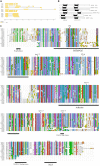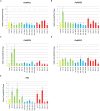Phylogenetic and expression analysis of the NPR1-like gene family from Persea americana (Mill.)
- PMID: 25972890
- PMCID: PMC4413732
- DOI: 10.3389/fpls.2015.00300
Phylogenetic and expression analysis of the NPR1-like gene family from Persea americana (Mill.)
Abstract
The NONEXPRESSOR OF PATHOGENESIS-RELATED GENES1 (NPR1) forms an integral part of the salicylic acid (SA) pathway in plants and is involved in cross-talk between the SA and jasmonic acid/ethylene (JA/ET) pathways. Therefore, NPR1 is essential to the effective response of plants to pathogens. Avocado (Persea americana) is a commercially important crop worldwide. Significant losses in production result from Phytophthora root rot, caused by the hemibiotroph, Phytophthora cinnamomi. This oomycete infects the feeder roots of avocado trees leading to an overall decline in health and eventual death. The interaction between avocado and P. cinnamomi is poorly understood and as such limited control strategies exist. Thus uncovering the role of NPR1 in avocado could provide novel insights into the avocado - P. cinnamomi interaction. A total of five NPR1-like sequences were identified. These sequences were annotated using FGENESH and a maximum-likelihood tree was constructed using 34 NPR1-like protein sequences from other plant species. The conserved protein domains and functional motifs of these sequences were predicted. Reverse transcription quantitative PCR was used to analyze the expression of the five NPR1-like sequences in the roots of avocado after treatment with salicylic and jasmonic acid, P. cinnamomi infection, across different tissues and in P. cinnamomi infected tolerant and susceptible rootstocks. Of the five NPR1-like sequences three have strong support for a defensive role while two are most likely involved in development. Significant differences in the expression profiles of these five NPR1-like genes were observed, assisting in functional classification. Understanding the interaction of avocado and P. cinnamomi is essential to developing new control strategies. This work enables further classification of these genes by means of functional annotation and is a crucial step in understanding the role of NPR1 during P. cinnamomi infection.
Keywords: NPR1; Phytophthora cinnamomi; avocado; expression analysis; jasmonic acid; pathogenesis-related; salicylic acid.
Figures





Similar articles
-
Advances in Understanding Defense Mechanisms in Persea americana Against Phytophthora cinnamomi.Front Plant Sci. 2021 Mar 1;12:636339. doi: 10.3389/fpls.2021.636339. eCollection 2021. Front Plant Sci. 2021. PMID: 33747014 Free PMC article. Review.
-
The expression of the NPR1-dependent defense response pathway genes in Persea americana (Mill.) following infection with Phytophthora cinnamomi.BMC Plant Biol. 2023 Nov 8;23(1):548. doi: 10.1186/s12870-023-04541-z. BMC Plant Biol. 2023. PMID: 37936068 Free PMC article.
-
De novo sequencing, assembly, and analysis of the root transcriptome of Persea americana (Mill.) in response to Phytophthora cinnamomi and flooding.PLoS One. 2014 Feb 10;9(2):e86399. doi: 10.1371/journal.pone.0086399. eCollection 2014. PLoS One. 2014. PMID: 24563685 Free PMC article.
-
Transcriptome analysis of an incompatible Persea americana-Phytophthora cinnamomi interaction reveals the involvement of SA- and JA-pathways in a successful defense response.PLoS One. 2018 Oct 17;13(10):e0205705. doi: 10.1371/journal.pone.0205705. eCollection 2018. PLoS One. 2018. PMID: 30332458 Free PMC article.
-
More stories to tell: NONEXPRESSOR OF PATHOGENESIS-RELATED GENES1, a salicylic acid receptor.Plant Cell Environ. 2021 Jun;44(6):1716-1727. doi: 10.1111/pce.14003. Epub 2021 Feb 3. Plant Cell Environ. 2021. PMID: 33495996 Review.
Cited by
-
Advances in Understanding Defense Mechanisms in Persea americana Against Phytophthora cinnamomi.Front Plant Sci. 2021 Mar 1;12:636339. doi: 10.3389/fpls.2021.636339. eCollection 2021. Front Plant Sci. 2021. PMID: 33747014 Free PMC article. Review.
-
Genome wide identification of the NPR1 gene family in plant defense mechanisms against biotic stress in chili (Capsicum annuum L.).Front Microbiol. 2024 Aug 5;15:1437553. doi: 10.3389/fmicb.2024.1437553. eCollection 2024. Front Microbiol. 2024. PMID: 39161600 Free PMC article.
-
CRISPR/Cas9-Mediated SlNPR1 mutagenesis reduces tomato plant drought tolerance.BMC Plant Biol. 2019 Jan 22;19(1):38. doi: 10.1186/s12870-018-1627-4. BMC Plant Biol. 2019. PMID: 30669982 Free PMC article.
-
Overexpression of NPR1 in Brassica juncea Confers Broad Spectrum Resistance to Fungal Pathogens.Front Plant Sci. 2017 Oct 4;8:1693. doi: 10.3389/fpls.2017.01693. eCollection 2017. Front Plant Sci. 2017. PMID: 29046679 Free PMC article.
-
Unraveling NPR-like Family Genes in Fragaria spp. Facilitated to Identify Putative NPR1 and NPR3/4 Orthologues Participating in Strawberry-Colletotrichum fructicola Interaction.Plants (Basel). 2022 Jun 16;11(12):1589. doi: 10.3390/plants11121589. Plants (Basel). 2022. PMID: 35736739 Free PMC article.
References
-
- Bekker T. F., Kaiser C., Labuschagne N. (2006). Efficacy of water soluble silicon against Phytophthora cinnamomi root rot of avocado: a progress report. S. Afr. Avocado Growers’ Assoc. Yearb. 29 58–62.
-
- Botha T., Kotze J. M. (1989). Exudates of avocado rootstocks and their possible role in resistance to Phytophthora cinnamomi. S. Afr. Avocado Growers’ Assoc. Yearb. 12 64–65.
LinkOut - more resources
Full Text Sources
Other Literature Sources
Research Materials
Miscellaneous

